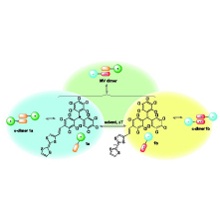Induced Self-Assembly of a Tetrathiafulvalene-Based Open-Shell Dyad through Intramolecular Electron Transfer.

J. Guasch, L. Grisanti, V. Lloveras, J. Vidal-Gancedo, M. Souto, D. C. Morales, M. Vilaseca, C. Sissa, A. Painelli, I. Ratera, C. Rovira, J. Veciana
Angew. Chem. Int. Ed. 2012, 51, 11024 –11028
DOI: 10.1002/anie.201203448

J. Guasch, L. Grisanti, V. Lloveras, J. Vidal-Gancedo, M. Souto, D. C. Morales, M. Vilaseca, C. Sissa, A. Painelli, I. Ratera, C. Rovira, J. Veciana
Angew. Chem. Int. Ed. 2012, 51, 11024 –11028
DOI: 10.1002/anie.201203448
We report a neutral organic openshell TTF-based dyad 1 which exhibits an intramolecular electron transfer phenomenon that enables the reversible switching from its neutral state 1a to its zwitterionic state 1b simply by modification of the solvent polarity being possible to attain the coexistence of both states 1a and 1b under certain conditions. Moreover, it has been demonstrated for the first time that the TTF-based self-assembly of this dyad is induced by the IET process between the donor and acceptor groups. In conclusion, we obtained a complex responsive molecular system that can be switched applying an external stimulus between different supramolecular architectures. This type of system can be viewed as a promising building block for “smart” functional supramolecular materials which can modify their electronic structure in response to external stimuli and are interesting because of their conductive and magnetic properties in solid state.






